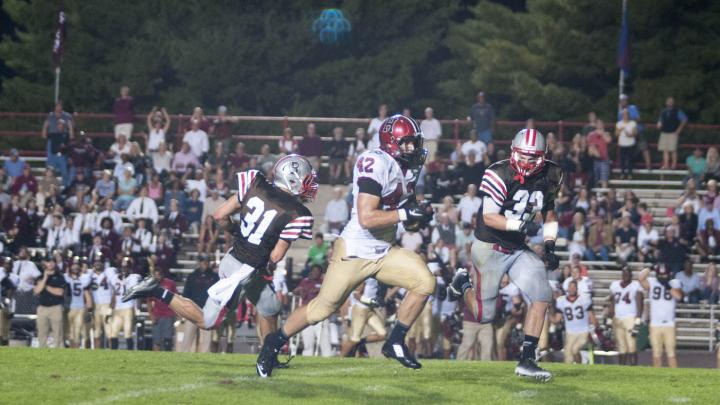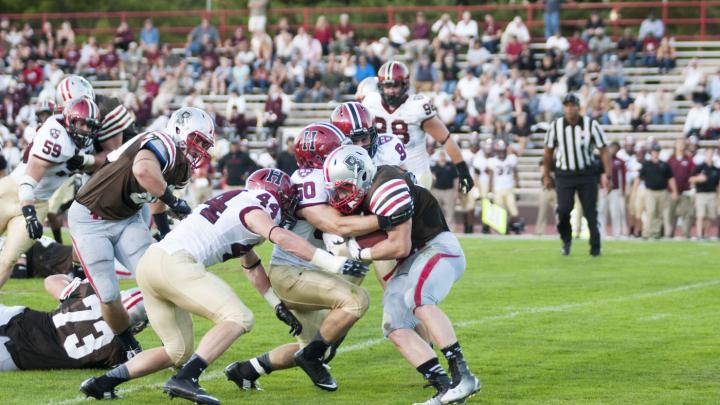After Saturday night’s game against Harvard at Brown Stadium, Brown treated the 13,511 spectators to a fireworks show as part of the university’s 250th anniversary celebration. Actually, the fireworks had begun about 45 minutes earlier. Trailing 14-6 and appearing whipped, the Crimson broke out for two touchdowns and a field goal to pull out a 22-14 win. The victory was doubly significant: it was the first Ivy League game of the season, and it was one Harvard could have, and maybe should have, lost.
The Crimson played without injured starting quarterback Connor Hempel ’15 and last year’s leading receiver, Ricky Zorn ’15, who missed his second straight game. In at quarterback stepped Scott Hosch ’16, who had performed solidly in relief of Hempel in the opening 41-18 victory over Holy Cross. On Saturday it took Hosch a while to fully find his rhythm, but he ended up completing 24 of 34 passes for 234 yards with no interceptions. Twelve of those completions went to wide receiver Andrew Fischer ’16, who amassed 115 yards and a touchdown. One player who did come off the injured list, 2013’s leading rusher, Paul Stanton Jr. ’16, barreled for 123 yards on 21 carries—and scored the momentum-turning touchdown. Meanwhile, a bend-but-don’t-break defense shut the Bruins down for the final 23 minutes.
After the game, Harvard coach Tim Murphy was effusive about Hosch, lauding his “grasp of the offense, poise, and good decision-making.” Overall, Murphy still saw “lots of room for improvement” (what coach doesn’t?), but said he appreciated that “the grit factor was there.”
The Crimson needed that perseverance. Things started promisingly enough in the first quarter, when Hosch engineered a nine-play, 57-yard touchdown drive that culminated in a nine-yard pass to Fischer. But, in what became a recurring theme, Ben Falloon ’15 missed the extra point and then, two series later, failed on a 37-yard field-goal attempt. These misses mattered dearly when Brown went 75 yards in eight plays and scored on an 18-yard touchdown pass from quarterback Marcus Fuller to wideout Reiley Higgins. Grant Senne’s kick was good, and the Bruins finished the half leading 7-6.
Brown scored again on its first drive of the second half—a 95-yard affair that back Andrew Coke finished with a one-yard run. This put Brown up 14-6, and Fuller was bamboozling the Crimson defense with short dropbacks that neutralized the pass-rushing of sack specialist Zack Hodges ’15, last year’s Ivy League Defensive Player of the Year. (Hodges was shut out of the sack column on the night.) But other Harvard defenders began plugging holes: linebacker Connor Sheehan ’15 (6.0 tackles for the game), defensive back Scott Peters ’16 and linebacker Matt Koran ’16 (5.0 tackles apiece), and defensive back Sean Ahern ’16 and tackle Doug Webb ’16 (4.0 tackles apiece). They helped the Crimson gain the field position that set up the game-turning play in the third quarter.
On third and eight from the Brown 43, Hosch handed the ball to Stanton, who bolted off right tackle, then cut back. Seconds later, he was in the end zone. Brown coach Phil Estes later lamented what might have been. “We had the right defense called,” said Estes, “and should have blown it up right at the point of attack.” This time Falloon kicked the extra point to make it 14-13.
On Brown’s next series, defensive tackle James Duberg ’16 stuffed Coke on a third-and-two. With 13:47 left in the game, Harvard got the ball back—on its own three-yard line. Now Hosch showed his resourcefulness. He wasn’t worried, later saying, “I know if we can execute, we can move the ball.” Making like John Elway, he orchestrated a drive that advanced the ball down to the Brown five, the key play coming on a beautiful crossing pattern executed by end Anthony Firkser ’17 that resulted in a 34-yard gain. On third-and-goal from the five, Hosch was harassed but coolly tossed the ball out of harm’s way, allowing Andrew Flesher ’15 to kick a 16-yard field goal that gave the Crimson a 16-14 lead.
Hosch was not done. Neither was Fischer. On the Crimson’s final drive—87 yards that chewed up 4:37—the duo hooked up five times, with Fischer deftly working the Brown flanks. (They were helped when Fischer suffered a helmet-to-helmet hit that cost Brown 15 yards.) With third-and-goal from the Brown three, Hosch faked a pitch and ran it in himself. Then Flesher missed yet another kick. The eight-point margin left the game in doubt until defensive back Chris Evans ’16 salted it away with an interception.
Fischer’s 12 catches doubled his previous game high, achieved twice (in 2013 against San Diego and last week against Holy Cross). He credited his rapport with Hosch to “lots of reps in practice,” adding that “we came into the game clicking.”
In the end, Harvard got away with one—and, providentially, now has two precious weeks to improve enough to satisfy Murphy before the next Ivy game, at the Stadium against Cornell on October 11.
Saturday’s win gave Murphy a 16-5 mark in Ivy openers. Harvard’s alltime mark against Brown is 82-30-2 in a series dating to 1893. There’s a huge asterisk: The Crimson won the first 21 games, all played in Cambridge. (The first game in Providence did not take place until 1952.) This year marks the centennial of Brown’s first non-loss in the series, a scoreless tie.
Earlier in that 1914 season, perhaps the greatest figure in Brown football history sat on the bench…the Harvard bench. Frederick Douglass Pollard ’18—known as Fritz—was an African American from Chicago, where he had made a reputation as a running back and track star at Lane Technical High. He had spent brief stints at Northwestern, Brown, Columbia, and Dartmouth (all the while playing semi-pro ball in his hometown). When he left Hanover, he went to Boston and straight to the office of William Henry Lewis, one of the nation’s most prominent African-American attorneys. More to the point, Lewis also had been an All-American center for Harvard and was a sometime Crimson coach. Realizing what he had in front of him, Lewis sprang into action the way he had done with a Yale ballcarrier in his sights. That same day Pollard found himself talking to a member of the Harvard admissions committee. Twenty-four hours later, on a Friday morning, Frederick Douglas Pollard was a member of the Harvard class of 1918, with the condition that he would make up his Spanish requirement the following summer.
The next day, Harvard, two-time defending national champions, played its opener against Bates. Cordially, Crimson captain Charlie Brickley ’15 arranged for Pollard to have a seat on the Crimson sideline. What Pollard remembered was the mob scene, with perhaps 100 players dressed. “I took a seat way down at the end of the bench,” he said. “Six inches more to my left and I’d have been in one of the water buckets.” He watched as Brickley scored four touchdowns against the hapless Mules. As the score mounted, coach Percy D. Haughton, A.B. 1899, was able to shuttle in subs.
After the game Pollard was walking across the field when he ran into a fellow he had played semi-pro ball against in Chicago, and who had become an assistant coach at Bates. The man began working on him. Did Pollard really think a small, African-American back would get any playing time in the star-studded Crimson backfield? And at Harvard, he’d really have to buckle down academically. Whereas Bates would be much more congenial...
By the end of the discussion, Pollard was headed for Lewiston, Maine. He’d spend a miserable autumn there, then return for another stint at Brown. The next time Pollard was at Harvard Stadium, it was as a member of the Bruins. In 1916, he scored two touchdowns to lead them to their first victory, 21-0, over the Crimson. In 1920, with the Akron Pros, Pollard was one of the first two African-American players in the nascent National Football League, and the league’s first black coach. Today, the Fritz Pollard Award annually honors the nation’s outstanding African-American college football coach.
Weekend roundup: The other six Ivy teams played non-league foes.
Yale 49, Army 43 (OT)
Villanova 41, Penn 7
New Hampshire 52, Dartmouth 19
Albany 42, Columbia 7
Bucknell 20, Cornell 7
Princeton 56, Davidson 17
Coming up: Next Saturday at noon, Harvard visits Georgetown. A member of the Patriot League, the Hoyas are 2-3 after losing to Colgate 19-0 on Saturday. For comparative purposes, Georgetown beat Brown 17-3 on Sept. 20.
SCORE BY QUARTERS
Harvard 6 0 7 9 22
Brown 0 7 7 0 14
Attendance: 13,511










